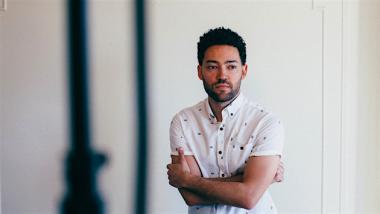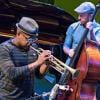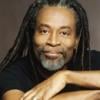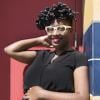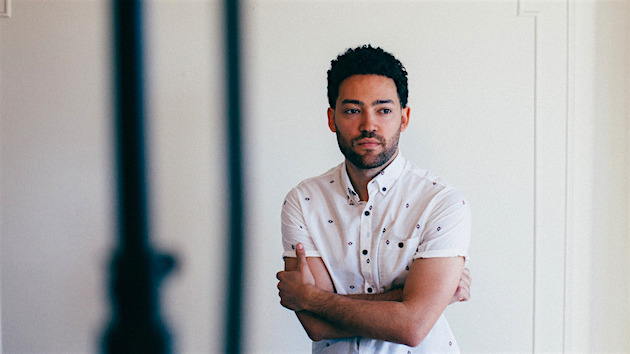
A veteran of countless concerts, the longtime SFJAZZ usher requested Taylor McFerrin’s penultimate show during the nonprofit performing arts organization’s 2018–2019 opening weekend. She’s a longtime fan of the keyboardist/vocalist/producer’s father, 10-time-Grammy-winning vocal wizard Bobby McFerrin and was curious about what musical adventures the junior McFerrin would lead his audience.
Taylor McFerrin is among a generation of twenty- and thirtysomething musicians that is working off the improvisational foundation of jazz and creating music with a 21st century, often technologically-infused aesthetic. Some, like McFerrin, are fulltime residents of that world. Others, including drummer Marcus Gilmore, switch between acoustic and more electronic settings.
Gilmore joined McFerrin for his eight-show/four-night run at the SFJAZZ Center’s hip, streetside Joe Henderson Lab venue. Gilmore is more than familiar with the building at Franklin Avenue and Fell Street having played the Center’s Miner Auditorium as a member of groups with more traditional instrumentations led by the likes of pianist Vijay Iyer and saxophonist Ravi Coltrane. He played there in another duo, one with master tap dancer Savion Glover, too. The grandson of jazz drumming great Roy Haynes and the nephew of trumpeter/cornetist Graham Haynes, Gilmore is also a member of a musical family.
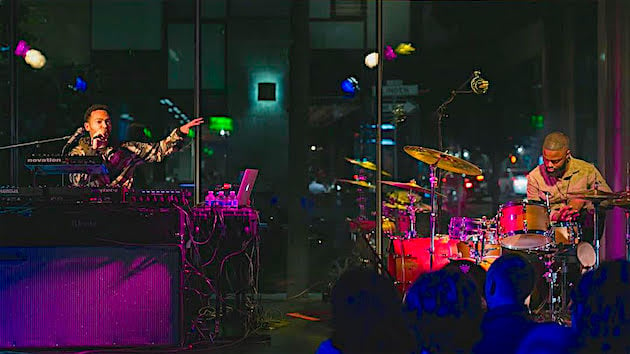
At their Joe Henderson Lab shows, McFerrin and Gilmore offered a variety of setups and deliveries. McFerrin might start with a sample or a vocal part and then layer various lines that would repeat atop one another. Gilmore would join in on drums, and McFerrin could respond in kind on keyboards. Or Gilmore might start a number with a flowing drum solo. It was spontaneous arrangement — something the senior McFerrin has made a vocal art form — and sometimes even extemporaneous composition with a one-time impromptu version of Radiohead’s “Everything in Its Right Place” the only cover performed during the residency.
A few hours prior to his 6:00 show on Sunday evening, McFerrin met with SFCV upstairs in the SFJAZZ Center’s “Bobby Hutcherson” dressing room to discuss his craft and approach. The southern California resident also talked about his upbringing in Minneapolis and one of the unusual non-familial circumstances that opened the door to music for him.
“I’ve often told people that my main influences were ’60’s and ’70’s kind of soul and fusion and a lot of rock music that had synthesizers in it,” McFerrin replied, when asked about gravitating towards vintage keyboards as his core instrument. “And then also the generation of hip-hop that really sampled that era,” a time period stretches roughly from the birth of that musical genre in the mid-1970s through the ‘90s.
“Those have been my main initial inspirations that formed my sonic palate,” he continued. McFerrin attended The New School in New York, which boasts the likes of pianist Brad Mehldau, saxophonist Marcus Strickland and keyboardist/pianist/current McFerrin collaborator Robert Glasper as alumni. They were all part of the school’s jazz program, while McFerrin was a liberal-arts major. But he did end up hanging out with and befriending some of its jazz students.
A San Francisco native, Taylor said that the only live music he caught while living in the Bay Area was at his father’s concerts until his family moved to Minneapolis. “I didn’t start realizing I was even into music until right after that,” he shared. “In eighth grade I had an hour-long bus ride to school every day. So that’s when I really got into listening to albums.
“That was the beginning of me falling in love with music. Then I started trying to make stuff probably two or three years after that,” he continued. While some teen musicians develop with their peers in the classroom, garages or band rooms, McFerrin explored his craft on his own in classic “bedroom musician” fashion.
“I started making beats when I was probably 16,” he revealed. “I was always recording and mixing my stuff on my own. I was never really working out of a real studio environment.”
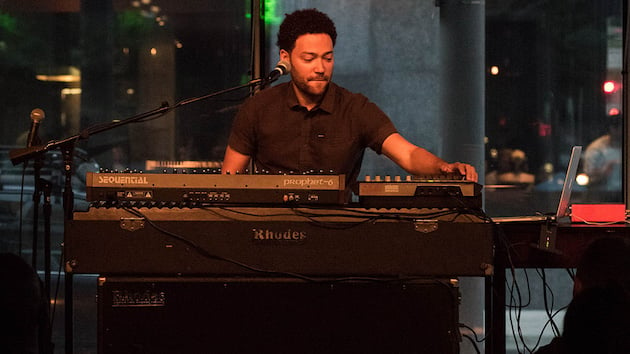
In a live setting, McFerrin uses two main keyboards: The Fender Rhodes, which has been the electric piano of choice of everyone from jazz legends Herbie Hancock and Chick Corea to fifth Beatle Billy Preston to soulful troubadour Donny Hathaway. He pairs that with a Prophet-6, the recently relaunched update of the famed Prophet-5 analog keyboard from 1977. He also runs Ableton music software through an Apple laptop and an external controller to help him record, mix, playback, and manipulate his recorded-on-the-spot loops.
“This set up allows me to mesh these worlds together seamlessly,” he explained. “The synthesizers just bring that feeling of that era. Most of the sounds that I design are on the more soulful end versus super aggressive or metallic sounding like of lot of other different types of synthesizers.”
Audiences steeped in contemporary electronic music are already familiar with McFerrin’s Ableton controller, and it’s not unusual for them to see a laptop among keyboards. Most crowds, whether at the SFJAZZ Center or a club in Brooklyn, have heard the Rhodes in a concert setting.
“A lot of shows, I’m playing to a really young crowd where it’s in a dance environment,” says McFerrin, 37. “My shows can be weird, because usually people don’t know what they’re supposed to do for the first 15 or 20 minutes. Since a lot of places I play are really clubs, a half an hour into the show I start going into music that people want to move to. And then that can be a whole different energy that sustains for the rest of the night.”
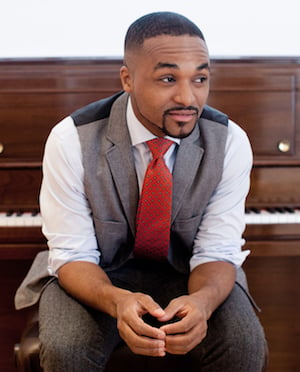
During the final show of his run, McFerrin had a couple of unnoticed celebrity fans in the wings. Vocalist Cécile McLorin Salvant and pianist Sullivan Fortner came over during intermission of their Miner Auditorium show and looked on for a bit while tucked into the Joe Henderson Lab side artist entrance. As McFerrin built up a rhythmic track by beatboxing, McLorin Salvant began to groove in place, and Fortner observed the bandstand with a seeming combination of admiration and curiosity.
Fortner and Gilmore’s history stretches back to high school, when both attended the prestigious Vail Jazz Workshop in 2002 along with trumpeter Josh Evans, pianist Gerald Clayton, and others.
“It’s just a classic meet-in-New York story,” McFerrin responded, when asked about how he and Gilmore, in turn, first connected. He shared a concert billing with vocalist Tiombe Lockwhere “about seven or eight years ago” at the Knitting Factory, and Gilmore was drumming with the singer.
After McFerrin signed with Brainfeeder, he participated in showcases for the label, which was founded by Steven “Flying Lotus” Ellison (himself a member of a jazz family as the late Alice Coltrane’s grand-nephew and Ravi’s first cousin once-removed). Gilmore was drumming with the bassist-vocalist Thundercat, another of the label’s artists.
“We ended up spending a lot of time chatting when neither of us were on stage,” McFerrin said. “(Marcus) is just so special. He’s got a really open vibe and is such a genuine person. So we kept in touch, and I did a session at his apartment where I recorded a bunch of his drum takes.
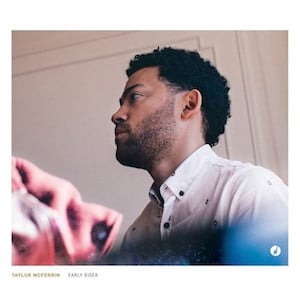
“One of those drum takes ended up being the drums on ‘Already There.’” The standout track can be found on McFerrin’s debut album, Early Riser, from 2014, and also features Glasper and Thundercat.
“Sometimes I’ll feel my limitations as a musician playing with Marcus because you can’t really throw him a curve ball,” McFerrin confessed. “He can totally handle it because he plays on such a high level, with guys like Chick Corea.
“But a lot of my music is coming from more of a beatmaker aesthetic. A lot of it is groove- and loop-based, so what he gives me the freedom to do is build up loops,” he said. “And then he adds a live element to that, adds another dimension, and I can totally take away the loops and machine and play free.
“It gives the show a dynamic that helps it stay fresh. I have figured out how to do a solo show on my own. But for me, I can kind of almost spiritually get to a different place playing with Marcus because there’s just that human interaction.”
The next night, McFerrin did a solo performance at the Kuumbwa Jazz Center in Santa Cruz. “The ticket sales were evenly split between members and nonmembers,” reported Bennett Jackson, Kuumbwa Jazz marketing director, in an email. “Our core member demographic is more middle-aged, so there were some collegiate audience members at the show.”
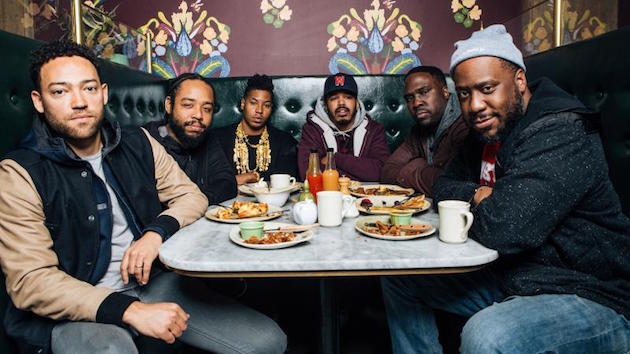
McFerrin was back in San Francisco eight nights later at the Regency Ballroom as a member of R+R = Now, a jazz/funk/R&B supergroup led by Glasper that features saxophonist/keyboardist/producer Terrace Martin, trumpeter Christian Scott aTunde Adjuah, bass guitarist Derrick Hodge, and drummer Justin Tyson. The crowd was young and energized, and in this band McFerrin yields Fender Rhodes duty to Glasper.
He does get a solo showcase about two-thirds through the show, which Glasper introduces as “Taylor Time.” McFerrin weaves his one-man band musical magic in front of another appreciative crowd before the rest of the group rejoins him onstage.
Gilmore returned the SFJAZZ Center two-and-a-half weeks after that as a member of Corea’s new Vigellete trio with the Cuban double bassist Carlitos Del Puerto. The drum set is placed sideways at the front of stage right so that he’s facing his bandleader’s grand piano. His playing is mesmerizing, almost balletic, and it’s hard to keep one’s eyes off of him and his augmented (though not monstrously so) drum kit.
Whether playing standards by Cole Porter or Duke Ellington, the late guitarist Paco de Lucía’s “Zyrab,” or Corea’s own classic “Spain,” the new trio played with a familiarity and ease as if they were longtime bandmates. Corea is no stranger to sonic explorations himself, having been on the vanguard of the ‘70s jazz fusion movement with his Return to Forever and inviting McFerrin and Gilmore perform with him at the in New York City as part of his eight-week 75th birthday residency last year at the Blue Note club.
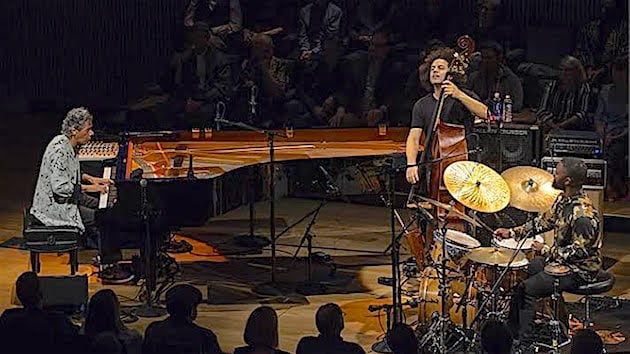
Speaking by phone, Gilmore compares his experiences playing with McFerrin and Corea at the SFJAZZ Center almost exactly a month apart. “Ultimately there are some similarities. But there are definitely differences, too,” he said. “Maybe there are more similarities than differences.
“With Chick it’s more orchestrated, though. There are more arrangements,” he noted. “And with Taylor, it’s more free flowing, generally speaking.”
An in-demand drummer, Gilmore is currently leading his own band in Europe with pianist David Virelles, keyboardist Big Yuki, and saxophonist/vocalist Casey Benjamin of Robert Glasper Experiment fame. “I love all of them,” he said, when asked about performing in various instrumental settings such as duos, piano trios and bands that feature a horn player or three. “I just don’t like doing any of them too much at one time.”
As for when he started incorporating electronics into his playing, it was a matter of the right technology becoming available for him: “I basically started a few years ago, because a friend of mine (Tlacael Esparza) had this really innovative idea to integrate electronics with drumset in a very specific way with these sensors that he created,” he described.
“They’re basically picking up vibrations from the drums and sending the signal to the computer. And you can arrange and program and manipulate the sounds in the computer to do different things depending on how you’re playing the drums. So you’re able to use the information that you have playing the drum and translate that into an electric experience, which I think is really fascinating.”
Playing in both plush concert halls and grittier nightclubs, Gilmore appreciates performing in a variety of settings. He likes free shows — particularly outdoor ones that can accommodate larger audiences — as it lowers the barriers for fans to hear music.
“It’s definitely nice to play for people closer to my age group,” the 32-year-old concluded. “But I appreciate playing for anybody that’s really open and into the music.”

